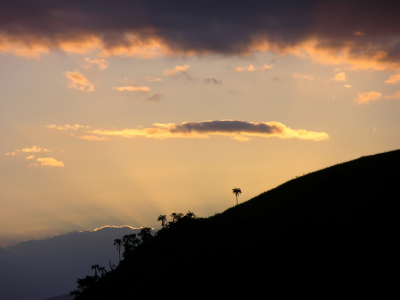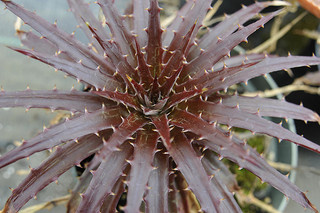Dyckia: A Prickly Pitcairnioideae
Author: Celeste Booth1 Comment
Care and Culture, Classification

Dyckia is a genus of bromeliad found within the Pitcairnioideae subfamily of bromeliads. There are 120 different species of Dyckia with many more cultivars. Each species of Dyckia is unique, but there are several characteristics that apply to most Dyckias, which make them standout from other bromeliads.
Origins of the Dyckias
Most Dyckias are native to Brazil, but a few originate from other South American countries such as Uruguay, Paraguay and Bolivia.
They prefer sunny and rocky terrain up to about 6,000 feet in elevation. Some Dyckias are saxicolous meaning they live attached directly to rocks. However, most are terrestrial, growing in the ground. The majority of other bromeliad genera are epiphytic. Another unique characteristic of the Dyckia is its ability to survive cold temperatures. Nearly all bromeliads cannot tolerate frost. However, many Dyckia can survive temperatures that drop into the teens. They won’t survive through harsh northern winters, but they can survive in outdoor gardens in a few climate zones that won’t support most other bromeliads.
Similar to Succulents
Dyckias are often confused with succulents because they look and play the part. They have stiff leathery leaves and are very drought tolerant, but unlike true succulents they cannot store their own water internally. They simply respond to periods of stress, such as dry weather conditions, by going dormant.
Form
Dyckias typically have long narrow leaves. Almost all Dyckias have sharp spines or hooks around the margins of each leaf. Dyckias can be found in shades of red, green, yellow and silver. Many of the plants appear to have a beautiful silver flocking on the spines and edges of the leaf. The leaves form a tight rosette that often curves down around itself, and they can drape beautifully over the sides of containers. They range in size from just a few inches across to several feet wide. Many of the plants within the genus have tall flower spikes that tower above the foliage. The flower spikes often produce only very small flowers in oranges, reds and yellows.
Unlike most other bromeliads, Dyckias can flower seasonally. Bromeliads are typically known for producing only one flower and then dying. Before they die they produce pups. Dyckias will continue to grow after they flower and even have the ability to flower again. A Dyckia planted from seed can take up to three years to reach maturity and bloom. Since Dyckias can continue living as long as they are well cared for, it is important to pay close attention to their container and potting medium.
Potting
The majority of bromeliads have very small root systems in which a small pot can house a full grown plant. In most cases, the bromeliad roots act only as anchors and not a primary source of nutrients. Dyckias, on the other hand, have extensive root systems and require containers that are at least as large as the plant itself. Dyckias will usually grow into the size of the pot where it is planted.
Propagation
Some Dyckias produce pups or offsets which is common among bromeliads. Other species don’t produce pups, but divide at the head. When planted in the ground, Dyckias can make thick ground cover. When grown in a pot, Dyckias will eventually need to be separated and replanted. Remove pups when they are at least half the size of the mother plant. Dyckia pups grow new roots very slowly. You can use a rooting hormone to encourage growth. Use a small pot until the roots are established and then repot in a larger container. You can employ a small saw to separate plants that have divided at the head. This is very difficult to accomplish without damaging one or both of the plants. Take care and time to separate the plants with as many of the roots intact as possible.
Even if you don’t want to separate your plants it is wise to repot them after two or three years. By this time the nutrients in the potting mix will be depleted. Carefully remove the plant. Then dump out any remaining potting mix. Clean the container well and rinse it well. Then place a new, well draining potting mix in the container and situate the plant back in the container. The Bromeliad Society/Houston recommends using a potting mix heavy in organic matter and includes water retaining polymers. Small rocks and pebbles make an excellent top dressing. Always use gloves and wear long sleeve shirts when handling sharp Dyckias.
Water
Dyckias can survive drought conditions but do not thrive in them. During the growing season – spring and summer – they require plenty of water. When they become too dry they will first stop growing and then wilt. They recover quickly once watered. Use fertilizer to encourage growth during the spring and summer. Stop fertilizing and allow the plant to dry more between waterings during the winter.
Sunlight

-Dyckias Need Plenty of Sun
Dyckias enjoy full sun. They can also tolerate lower light levels, but it may change the color of the leaves. The Bromeliad Society/Houston suggests 5000 foot-candles for best results when growing a Dyckia.
Varieties
There are many popular varieties of Dyckias for beginner growers, as well as rare species that will entice bromeliad enthusiasts. Prices range from $10 dollars to $155 for the most rare species.
- Dyckia ‘Arizona’ is a popular cultivar that has narrow burgundy leaves with white spines. The rosette forms a beautiful star shape. The cultivar is particularly adapted to arid climates.
- Dyckia ‘Naked Lady’ is a cultivar that is spineless. It has light green to yellow leaves. This plant can grow over 12 inches tall.
- Dyckia fosteriana has beautiful silvery white leaves with many spines. It forms a tight rosette with leaves that drape downward. The plant can grow up to 8 inches wide.
- Dyckia ‘Cherry Coke’ has glossy leaves. Its name is suitable because the leaves are the color of Cherry Coke. The plant can grow very large with leaves up to 2 feet in length and displays a 4 foot upright flower stalk. The plant also pups well.
- Dyckia delicata comes in various forms. Leaf colors include green, red and silver depending on the form of the plant. All forms appear to be beautifully flocked with silver. Native to higher altitudes in southern Brazil, these plants are well suited to cooler winter weather. It is a beautifully shaped plant with a tight rosette draping downward.
- Dyckia brevifolia has short, wide green leaves with very small spines around the margins. While drought tolerant, these plants can also survive chilly and wet weather. They grow about 8 inches wide and have a beautiful small yellow flower which grows on a flower stalk.
All Shapes and Sizes
Dyckias come in all shapes and sizes. They share in common their love for sun and tolerance for drought. They do not require the moist, humid conditions that so many other bromeliads do. They are long-living and beautiful in form and color. These plants are an excellent addition to a mild climate landscape or a bromeliad enthusiast’s rare collection. Dyckias are another enjoyable expression of the vast family of bromeliads.
Sources
“Dyckia brevifolia.” Ecology and Evolutionary Biology Plant Growth Facilities. University of Connecticut. <http://titanarum.uconn.edu/199900591.html>
“Dyckia.” Bromeliad Society/Houston. <http://bromeliadsocietyhouston.org/genera-intro/dyckia/>
Dyckia Brazil. <http://dyckiabrazil.blogspot.com/search?updated-max=2012-11-26T18:44:00-02:00&max-results=20&start=31&by-date=false>
“Dyckia.” Danger Garden. <http://dangergarden.blogspot.com/2010/03/awhile-back-i-was-researching-genus.html>
“Dyckia.” HowStuffWorks. <http://home.howstuffworks.com/dyckia.htm>
Florida Council of Bromeliad Societies Bromeliad Photo Index. <http://fcbs.org/pictures.htm>
Tropiflora. <http://tropiflora.safenetserver.com>
photo credit: Marcia Stefani via http://www.flickr.com/photos/restingas/4030113296/
photo credit: MeganEHansen via http://www.flickr.com/photos/nestmaker/5047961201/
One response on “Dyckia: A Prickly Pitcairnioideae”
Leave a Reply

Resource Download
Hechtia Care Cheat Sheet
Learn how to care for your Hechtia bromeliad with this quick and easy informational guide.
Learn More
Ask an Expert
Questions about bromeliads?
Our experts love a challenge!
Photo of the Week
Submit your photo to be featured on the blog!
More Photo of the Week Winners
Submit Photo









Which species has red flower blooms.